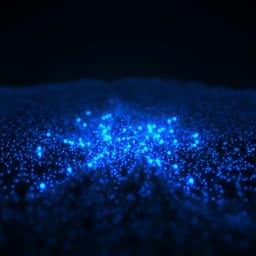
Engineering and Technology
Bright, efficient, and stable pure-green hyperfluorescent organic light-emitting diodes by judicious molecular design
Y. Lee, C. Chan, et al.
Discover groundbreaking research by Yi-Ting Lee and colleagues on the development of stable and efficient pure-green organic light-emitting diodes (OLEDs) that meet the stringent demands for ultra-high-definition displays, achieving impressive performance metrics like external quantum efficiencies exceeding 25% and long device stability.
~3 min • Beginner • English
Introduction
Thermally activated delayed fluorescence (TADF) OLEDs based on precious-metal-free emitters are promising for sustainable, high-performance displays, but current devices struggle to simultaneously achieve high efficiency, color purity, brightness, and stability. Donor–acceptor (DA) TADF emitters can reach high internal quantum efficiencies but typically exhibit broad charge-transfer emission that fails to meet stringent green color gamut requirements (CIEy ≥ 0.7) for NTSC and BT.2020. Multi-resonance emitters (MREs) offer narrowband emission and high PLQY, and while pure-green MRE-based OLEDs exist, those achieving CIEy ≥ 0.7 often suffer from poor stability and efficiency rolloff. Additionally, achieving the required CIEx values (0.21 for NTSC and 0.17 for BT.2020) is often overlooked or compromised. This study aims to design and synthesize new pure-green MREs and integrate them into TADF and hyperfluorescent (HF) OLED architectures to realize devices that concurrently meet color purity (x and y), high efficiency, high brightness, and improved operational stability.
Literature Review
DA-type TADF OLEDs have achieved EQEs up to ~40% through rational donor/acceptor design, but their broad CT emission limits color purity in green. The NTSC green is (0.21, 0.71) and BT.2020 requires CIEx = 0.17 for UHD. Multi-resonance TADF emitters introduced by Hatakeyama et al. in 2016 provide narrowband emission with high PLQY and have enabled full-color narrowband OLEDs, including pure-blue and pure-red. Recent pure-green MREs have delivered high efficiencies with CIEy ≥ 0.7, yet device stability and efficiency rolloff remain unsatisfactory. Prior pure-green ω-DABNA showed PL at 509 nm and EL at 512 nm with CIEx,y = (0.13, 0.73), but CIEx and stability were inadequate. There is a clear need for molecular designs that redshift emission while preserving narrowband spectra and improving device stability, and HF architectures that manage exciton dynamics to suppress rolloff.
Methodology
Molecular design and synthesis: Two ω-DABNA derivatives were designed to redshift emission while retaining narrowband character: ω-DABNA-M (methyl substitution to increase donor strength via inductive effect) and ω-DABNA-PH (phenyl substitution to extend π-conjugation via mesomeric effect). Both were synthesized by sequential two-step Friedel–Crafts borylations following reported ω-DABNA protocols. Products and intermediates were characterized by NMR and mass spectrometry.
Computational studies: TD-DFT and TDA-B2PLYP(cx=0.40, cc=0.23)/cc-pVDZ//M06-2X/6-31G(d) calculations estimated HOMO/LUMO energies and excited-state properties. S1 energies and ΔES1–T1 were computed; SOC matrix elements between S1 and Tn were evaluated. Cartesian coordinates are provided in Supplementary Tables.
Photophysics: Thin films (1 wt% in PMMA) of ω-DABNA, ω-DABNA-M, and ω-DABNA-PH were prepared to measure absorption, PL maxima, FWHM, PLQY, prompt/delayed lifetimes, and kRISC. HF films using sky-blue TADF assistant dopant 3Cz2DPhCzBN (T1 = 2.72 eV) with suitable spectral overlap were prepared to measure delayed lifetimes and PLQYs.
Electrochemistry: Cyclic voltammetry (CV) determined HOMO energies from oxidation onsets with Fc/Fc+ internal standard in DMF/TBAPF6 (0.1 M); LUMO energies were estimated from HOMO and optical gaps.
Device fabrication: TADF OLED structure (devices A–C): ITO (50 nm)/NPD (40 nm)/TCTA (15 nm)/mCP (15 nm)/DOBNA-Ph: 0.5 wt% MRE (20 nm)/3,4-2CzBN (10 nm)/BPy-TP2 (20 nm)/LiF (0.8 nm)/Al (100 nm). HF OLED structure (devices D–I): ITO (100 nm)/HAT-CN (10 nm)/tris-PCz (30 nm)/mCBP (5 nm)/mCBP: 20 wt% 3Cz2DPhCzBN: MRE (0.5 or 1 wt%) (30 nm)/SF3-TRZ (10 nm)/SF3-TRZ: 30 wt% Liq (30 nm)/Liq (2 nm)/Al (100 nm). HF with green assistant dopant (devices J–K): same as H–I but 3Cz2DPhCzBN replaced by 4CzIPN; reference devices with only assistant dopant (Ref-1: 20 wt% 3Cz2DPhCzBN; Ref-2: 20 wt% 4CzIPN) were also fabricated.
Measurements: EL spectra, EQE–luminance, J–V–L, and operational lifetime LT95 at initial luminance of 1000 cd m−2 were recorded. Transient EL (TrEL) assessed exciton dynamics and trapping; temperature-dependent transient PL and absolute PLQY measurements were performed with specified spectrometers. OLEDs were fabricated by vacuum deposition in inert atmosphere and encapsulated in N2.
Key Findings
Molecular/photophysical: Calculations showed ω-DABNA-M HOMO/LUMO at −4.47/−1.39 eV (inductive methyl raises both levels), ω-DABNA at −4.61/−1.50 eV, and ω-DABNA-PH HOMO/LUMO at −4.67/−1.66 eV (phenyl stabilizes LUMO via mesomeric effect). Computed S1 energies: 2.357 eV (ω-DABNA), 2.326 eV (ω-DABNA-M), 2.272 eV (ω-DABNA-PH); ΔES1–T1 reduced from 75 meV to 67 and 65 meV for M and PH. SOC elements increased notably for ω-DABNA-PH (S1–T1 0.022 cm−1; S1–T2 0.475 cm−1). In 1 wt% PMMA, λabs ≈ 495–502 nm; PL maxima: 509 (ω-DABNA), 514 (M), 512 (PH); narrow FWHM: 22–28 nm; PLQYs ~86–87%. Delayed lifetimes shortened from 8.95 μs (ω-DABNA) to 5.04 μs (M) and 4.70 μs (PH); kRISC increased from 1.2×10^5 s−1 to 2.1–2.2×10^6 s−1. HF films with 3Cz2DPhCzBN showed fast delayed lifetimes: 0.99 μs (ω-DABNA), 0.78 μs (M), 0.75 μs (PH); PLQYs: 58%, 69%, 74%.
Electrochemistry: Experimental HOMO (eV): −5.26 (ω-DABNA), −5.21 (M), −5.24 (PH); LUMO (eV): −2.82 (ω-DABNA), −2.79 (M), −2.82 (PH), consistent with calculations.
TADF devices (A–C, 0.5 wt% MRE): A (ω-DABNA): EL 512 nm, FWHM 25 nm, CIEx,y (0.13, 0.73), EQEmax 30.8% (29.2% at 1000 cd m−2), LT95 34 h. B (ω-DABNA-M): EL 515 nm, FWHM 25 nm, (0.15, 0.74), EQEmax 32.7%, LT95 24 h. C (ω-DABNA-PH): EL 521 nm, FWHM 30 nm, (0.19, 0.74), EQEmax 32.7%, LT95 27 h.
HF devices with 3Cz2DPhCzBN (D–F, 0.5 wt% MRE): D (ω-DABNA): EL 511–513 nm with residual assistant emission, (0.15, 0.64), EQEmax 28.0%, EQE 19.5% at 10^4 cd m−2, Lmax 92,351 cd m−2, LT95 188 h. E (ω-DABNA-M): 515 nm, FWHM 30 nm, (0.18, 0.65), EQEmax 28.3%, EQE 19.4% at 10^4 cd m−2, Lmax 84,098 cd m−2, LT95 230 h. F (ω-DABNA-PH): 515–521 nm, FWHM 25–30 nm, (0.20, 0.66), EQEmax 27.3%, EQE 21.1% at 10^4 cd m−2, Lmax 134,631 cd m−2, LT95 205 h; efficiency rolloff minimized (9.8% between 1 and 1000 cd m−2).
HF devices with increased MRE concentration (G–I, 1 wt% MRE): Enhanced FRET reduced assistant emission. G (ω-DABNA): EQEmax 26.8%, (0.14, 0.69), EQE 16.8% at 10^3 cd m−2, LT95 143 h. H (ω-DABNA-M): EQEmax 28.2%, (0.17, 0.70) close to BT.2020 x, EQE 16.6% at 10^3 cd m−2, LT95 110 h. I (ω-DABNA-PH): EQEmax 26.5%, (0.21, 0.69) matching NTSC x, EQE 19.6% at 10^3 cd m−2, Lmax 155,964 cd m−2, LT95 109 h.
HF devices with 4CzIPN assistant (J–K, 1 wt% MRE): Ref-2 (20 wt% 4CzIPN): EQEmax 21.1%, EL 528 nm, (0.33, 0.60), LT95 403 h. J (ω-DABNA-M): EQEmax ~19.1–19.9%, EL ~517–522 nm, FWHM ~26–30 nm, (0.27, 0.66), LT95 63 h. K (ω-DABNA-PH): EQEmax 24.4%, EL 522 nm, FWHM 30 nm, CIEx,y (0.24, 0.70), LT95 580 h at 1000 cd m−2. Overall, HF devices achieved EQE >25%, maximum luminance >10^5 cd m−2, suppressed rolloff (≈20% EQE at 10^5 cd m−2), and extended stability up to LT95 ≈ 600 h while meeting green color targets near NTSC/BT.2020.
Discussion
The study demonstrates that judicious modification of ω-DABNA can redshift emission while maintaining narrowband spectra and high PLQY, enabling pure-green emission with CIEy ≥ 0.7. Methyl substitution (inductive effect) elevates HOMO/LUMO and narrows the gap moderately, whereas phenyl substitution (mesomeric effect) stabilizes LUMO more strongly, introduces slight CT character, and yields the largest redshift with small ΔES1–T1 and enhanced SOC. These molecular changes shorten delayed lifetimes and increase kRISC, which benefit device performance. In TADF devices, all three MREs deliver high EQEs (>30%) with y ≥ 0.74; however, stability remains limited. Transitioning to HF architectures transfers exciton management to the more robust TADF assistant dopant, reducing triplet population on the MRE and suppressing efficiency rolloff while boosting operational lifetime by 6–10×. At low MRE loading (0.5 wt%), incomplete FRET leads to assistant emission and suboptimal CIE; increasing MRE loading to 1 wt% improves color purity, achieving CIEx values aligned with BT.2020 (0.17) using ω-DABNA-M and NTSC (0.21) using ω-DABNA-PH while retaining CIEy ≈ 0.7. Phenyl substitution (ω-DABNA-PH) also enhances conductivity and brightness. TrEL analyses reveal hole trapping linked to HOMO level alignment, especially at higher ω-DABNA-M loadings, correlating with reduced lifetime. Device stability in HF OLEDs ultimately depends on the assistant dopant; replacing 3Cz2DPhCzBN with 4CzIPN significantly extends LT95 to ~580 h while preserving narrowband green emission with CIEy ≈ 0.70. These results validate the combined molecular and device-architecture strategy to concurrently achieve stringent color purity, high efficiency, high brightness, and improved stability for UHD displays.
Conclusion
Two new pure-green multi-resonance emitters, ω-DABNA-M and ω-DABNA-PH, were designed and synthesized to redshift emission and enhance TADF characteristics relative to ω-DABNA. Integrated into both TADF and hyperfluorescent OLEDs, they delivered pure-green emission with CIEy ≥ 0.7, and in HF architectures achieved CIEx meeting NTSC (0.21) and near BT.2020 (0.17) targets. The devices exhibited high peak efficiencies (≥27–33% in TADF; ≥26–28% in HF), ultra-high brightness (>10^5 cd m−2), suppressed rolloff (≈20% EQE at high luminance), and extended operational stability up to LT95 ≈ 600 h when paired with a stable assistant dopant (4CzIPN). The work underscores the importance of mesomeric versus inductive substitution in tuning MRE energetics and the critical role of assistant dopant selection and dopant concentration in balancing FRET efficiency, trap formation, color purity, and lifetime. Future research should focus on optimizing assistant dopant stability and spectral overlap, mitigating charge trapping via energy-level alignment, exploring alternative high-stability TADF assistants, and refining MRE structures to further narrow FWHM while maintaining target CIEx,y and operational robustness.
Limitations
MRE-only devices, while efficient, still show limited operational stability. In HF devices, color purity at low terminal-emitter loading (0.5 wt%) suffers from incomplete FRET, and increasing MRE concentration (1 wt%) can introduce hole traps (especially with ω-DABNA-M), degrading lifetime. The phenyl-substituted emitter exhibits slightly broadened FWHM. Device lifetime improvements are highly dependent on the assistant dopant’s intrinsic stability and spectral overlap with the terminal emitter; generalizability across different assistant dopants is not fully established. Stability under prolonged ultra-high brightness and across larger-area devices was not extensively reported.
Related Publications
Explore these studies to deepen your understanding of the subject.







